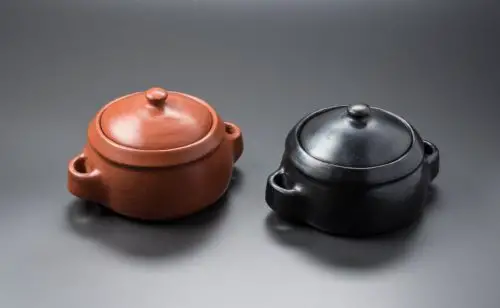Translated by Nick R
Around the world, there are many towns and cities whose foundations lie in the ancient art of pottery.
Pottery has shaped the history of different places all over the world for thousands of years and 11 towns and cities, in particular, have a pottery tradition that is still alive and strong today.
In this blog we will share all about these destinations: the history and characteristics of the pieces from regions with a rich pottery tradition in Latin America, Europe, and Asia. The best sites with ceramic tradition are:
- Juan Mata Ortiz, Mexico.
- Capula, Mexico.
- Quimbaya, Colombia.
- Ráquira, Colombia.
- Sargadelos, Spain.
- La Bisbal del Ampurdán, Spain.
- Talavera de la Reina, Spain.
- Llamas del Mouro, Spain.
- Meissen, Germany.
- Jingdezhen, China.
- Arita, Japan.
First, we will explore Latin American destinations, and continue with those in Europe, to finish in Asia so you can understand easier. Let’s get started!
Table of Contents
Destinations with ceramic tradition in Latin America
1. Juan Mata Ortiz, Mexico
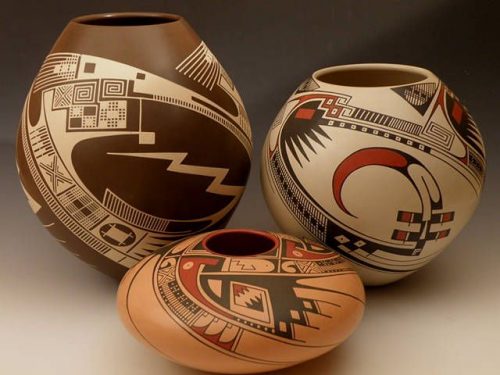
Mata Ortiz is a locality in the state of Chihuahua in Mexico that is very close to the archaeological site of Paquimé. There, about 3 generations ago, the manufacture of ceramic pieces resurfaced thanks to the potter Juan Quezada who shared his knowledge with these people, and Spencer McCallum, who sponsored Juan.
As in many towns, all its history can be seen through these ceramic objects. It will continue to be so in the future, as there is still so much talent that more than 450 potters live there, some of whom have received national awards for this art, such as the National Ceramics Award.
Mata Ortiz pottery is made using ancestral techniques used by the Paquimé culture. The people who inhabited this place before, with mineral and lead-free paint designs.
Its pieces, mostly vessels and pots are entirely handmade in approximately one to three months. Also, two main elements were used for their firing: aspen tree bark husk and boñiga; dried cow dung. This is the characteristic rustic firing style that characterizes their pieces.
To model their pieces, they use the coiling technique as follows: first, they knead the clay thoroughly, then place some of it in a plaster mold in the shape of a plate, form a coil, and lay it on the edge of the mold and then join it to the edge of the mold by stretching the clay, while creating the walls of the vessel at the same time.
It is an ancient technique, but it is still widely used today because it is one of the easiest techniques as it does not require many tools other than the hands.
The characteristic style of Marta Ortiz’s pieces is due to Quezada, a potter who used to employ ocher and reddish colors accompanied by very symmetrical geometric designs that are still very much in use today in each of the pieces made in this town.
2. Capula, Mexico
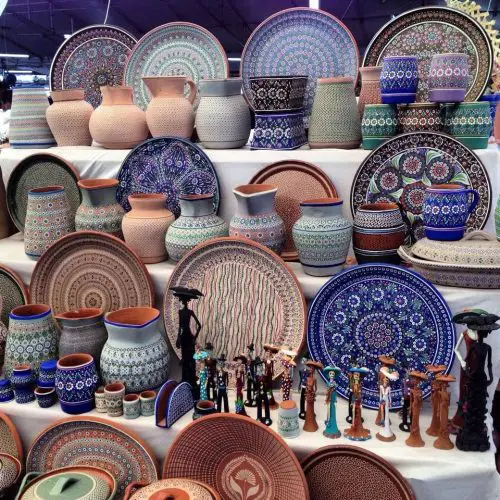
Capula is a little town in Michoacán and is one of the most internationally recognized places of Mexican handicraft production for making ceramic pieces such as Catrinas, skulls, craniums, tableware, cups, flowerpots, suns, moons, and frogs, among others.
The most renowned piece from Capula is the Catrina, and we will explain why. However, besides this famous piece decorated in cold with acrylic paints, you will also find a variety of glazed utensils for domestic use, such as plates and pots.
The Catrina may be the most representative icon of Mexican culture, and Capula town is honored to claim that this figure was born there. It was in the 1970s that potter Juan Torres made this great icon of Mexico in his workshop using the stippled pottery: the hallmark of Capula’s ceramics.
The Catrina is such an important icon of Capula that it has its own fair: La Feria de la Catrina, which is held in the last week of October and the first of November. It is an enormous opportunity to see all the art and effort of the artisans who exhibit their most beautiful pieces on the main streets of the town.
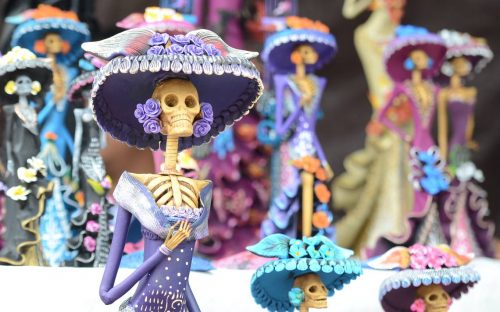
You may be wondering, “What is stippled pottery?” You see, it is a form of decoration characterized by having many very tiny dots printed on the clay. It makes some designs have mobility, like flowers and animals. The favorite colors used to make them are red, black, white, green, blue, and yellow.
The manufacturing process of their pieces is very simple. First, they grind the clay mixture with a ceramic paste and then knead the dough until it reaches the desired consistency to start modeling it on a potter’s wheel.
They use two firing techniques to bake their pieces: one in a wood-fired kiln and the other in a high-temperature gas kiln, resulting in better-finished pieces that are more resistant and, therefore, more expensive than those made in a wood-fired kiln.
All of their pieces are fired twice, the first at more than 1,200 °C (2200 °F) and the second at 1,800 °C (3200 °F). However, in between these two firings, the clay is glazed with lead to make it shiny, resistant, and impermeable, which is necessary for items like vessels.
3. Quimbaya, Colombia
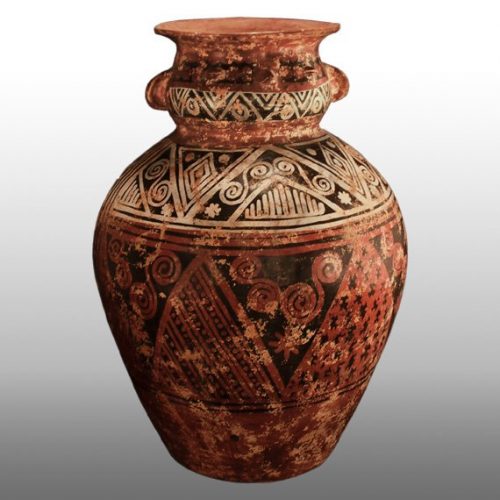
This pottery, named after its people, began between 500 B.C. and 600 A.D., and its first pieces were made of gold and clay, in which aspects of their community’s daily life and beliefs were depicted.
It is one of the most renowned ceramic Colombian villages because of its ceramic tradition. If you want to make a trip to pottery towns in this country, you have to visit Quimbaya in the department of Quindio.
Among the pieces made in Quimbaya pottery, we find human figures, bowls, vases, jugs, bowls, musical instruments, and pitchers. Among others such as composite silhouette pots, whistling pots, bowls, cups, alcarrazas, and burial urns; are the most recognized objects of these people.
For Quimbaya ceramics, elaboration and decoration varied depending on the zone. For example, in the south, the pieces were painted red on the bottom and black on top. And in the north of Cauca with brown and gray or orange with white decorations.
Their pottery is recognized for having few colors, being decorated with geometric designs, and for shapes that resemble a balloon as they are large and round. Learn more about Quimbaya pottery in our blog.
4. Ráquira, Colombia
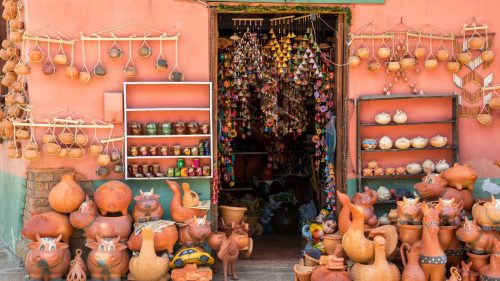
Known as the Artisan Capital of Colombia and exactly because of the quality of its crafts, it is one of the main tourist destinations in Boyacá and the whole country. It has a long tradition in the art of pottery from its origins, as everything was born from the Muisca people who used to live there.
This pottery expertise was passed down over generations, and with the opening of the first pottery school in Raquira in 1936, the new generations were allowed to innovate, and thus they created unusual forms. One example is the ashtrays with the head of the Red Skin Indian.
One example is the ashtrays with the Red Skin Indian head.
As a town whose origins are absolutely linked to ceramics, Ráquira today is full of pottery everywhere, in every street, wherever you look. Indeed, that is the best feature of this town: its richness of pottery types, shapes, and models.
Most of its pieces have reddish colors, but many others are vividly colored, just as the town is. Regarding shapes, most of them are classic objects like pots, pans, and cups. However, other emblematic pieces of the town are the clay horses, the virgins, and the bullrings.
If you want to visit a place full of pottery tradition, Ráquira is the right destination to spend a couple of days exploring each of its pottery stores which, by the way, are all located side by side. You can start the tour in the main square with its colorful houses and go through the surrounding streets, where you will find a wide variety of pieces and prices.
Embark on a captivating journey to uncover the vibrant ceramic traditions of Quimbaya and Ráquira. Delight in the extraordinary richness of Colombian ceramics, craft your personalized journey with expert Colombia travel designers and let yourself live unique travel experiences in Colombia around the fascinating world of pottery.
Destinations with ceramic tradition in Europe
5. Sargadelos, Spain
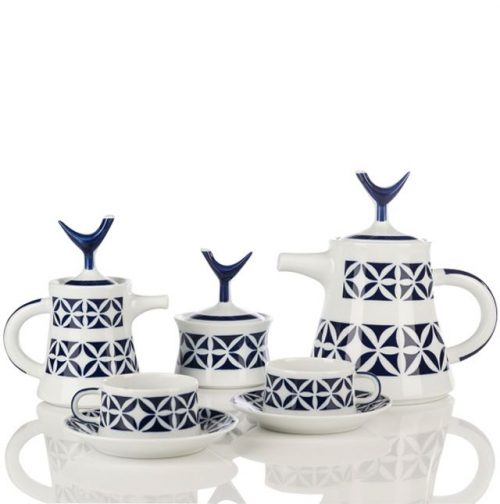
This is a Spanish village in the municipality of Cervo, in the province of Lugo. Here, from 1806, white clay ceramic pieces have been created with a very characteristic design that surely we have all seen at some point.
The identity of Sargadelos ceramics lies in the originality of its designs, most of them inspired by Galician and Celtic traditional motifs and shapes. Every piece is full of these patterns.
This factory was inaugurated in Cervo’s town hall parish and was declared an Asset of Cultural Interest in the category of Monument in 2014. It is no longer only a factory; it has also a great museum where you can admire this art and buy pieces to bring to your home.
The most common piece produced in Sargadelos is crockery. That is so since it is made of white earthenware that suits perfectly to accompany a meal with friends or family. Additionally, the vast majority own pieces in that dark blue color so characteristic of Sargadelos.
6. La Bisbal del Ampurdán, Spain
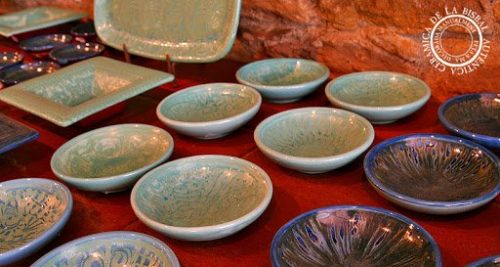
La Bisbal is one of the major ceramic centers of Catalonia and Spain and is 100% oriented to the commercialization of all types of ceramic products. If they are not all ceramic workshops, these companies supply equipment and machinery for workshops. Literally everything there revolves around the art of pottery.
Pottery is and has been one of the principal economic enterprises of this town since the 18th century. It is said that the first record of this activity in La Bisbal dates back to 1502. Over this time, the identity of its pieces has developed around brightly colored glazes and very simple or almost nonexistent decorations.
People in this town were so astute that they registered the trademark ¨Cerámica de La Bisbal¨. Besides, every year, one of the most relevant handicraft fairs in Spain is celebrated on different dates depending on the year. What a great way to attract the public and sell their utilitarian pieces, don’t you think?
Not only are there workshops and companies working for ceramics, but also different activities at an institutional level like the School of Ceramics for future generations to learn this art and the Terracotta Museu, a ceramics-only museum. Besides, it is one of the few institutions in Catalonia intended to guarantee the preservation, conservation, and promotion of the material and cultural heritage of ceramics. Fantastic!
7. Talavera de la Reina, Spain
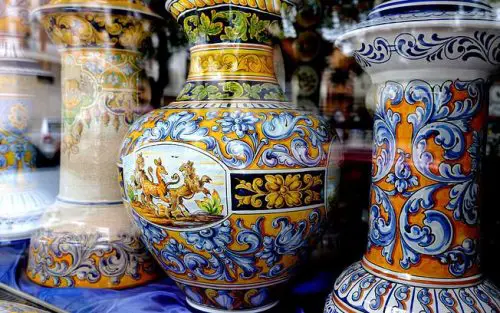
Talavera is known as The City of Ceramics since, for five centuries, it has been growing full of ceramic tradition by producing thousands and thousands of pieces, so much so that in 2015 Talavera pottery was declared an Asset of Cultural Interest.
Although this pottery comes from Spain, there was a time when it expanded so much that it reached America, and Mexican potters gave it a touch of their own. Today it is a common trait shared by both countries.
The principal items created in this city are made of earthenware clay and are decorated with metallic glazes. In addition, they have three main uses; domestic, for pieces such as plates, jugs, and vases; decorative, and in the form of tiles.
In addition to its uses, shapes, and colors, Talavera pottery has one more aspect that makes it extremely special and unlike any other: its elaboration process.
To create a piece, artisans step on the clay to burst the air bubbles and remove any impurities, and then mold it on a potter’s wheel. It is left to dry for a few days and then fired for the first time at 850 °C (1500 °F).
Next, they apply the initial white glaze and decorate it with some of the most recognized colors of their pottery, such as blue, yellow, orange, green, and mauve. Finally, it is fired a second time to make it look shiny. The elaboration of one of these pieces can take between one and three months of work.
All this work was recognized by the United Nations Educational, Scientific, and Cultural Organization (Unesco) as part of the Intangible Cultural Heritage of Humanity.
8. Llamas del Mouro, Spain
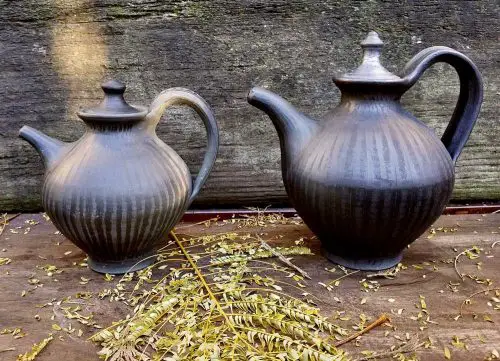
It is located in Asturias, Spain, and its pottery differentiates from others in the country for the black color achieved by firing the pieces in a wood-fired kiln which they cover when the art pieces are done so that they don’t breathe. The smoke is what gives them their black color.
This tradition is present in Llamas de Mouro since the 1930s. Each one of the skills acquired over so many years has been passed down from generation to generation. Nowadays, it is the only place in Spain that still makes black pottery thanks to the sons of the potter Jesús Rodríguez Garrido.
Llamas pottery is also valued for its resistance and the excellent food preservation qualities of these pieces. However, all this is thanks to an exhaustive elaboration process.
First, the clay must be chosen very carefully. Potters use two types, a clear one that they let to rest in water and the ¨colorao¨ that must be crushed before mixing. They knead the dough properly to create a ball sized to fit the piece to be made and then mold it on a potter’s wheel.
After being molded and allowed to harden slightly in the sun, the pieces are polished with sea stone that also serves for printing and creating designs on them with parallel lines or circles as a base.
Sometimes crafters use an incision decoration technique with an awl to get nice rips. Then, the pieces are taken to the kiln and covered with bits of pots and earth with grass. These are gradually changed when the previous ones are consumed by the fire.
For the cooking process, the mix of firewood is also fundamental. Here, materials with high-calorie content to offer, such as dried heather or oak vines, are used, as well as piorno roots and other natural firewood from the area.
Most of the pieces decorated with this stunning shiny black color are pitchers, pots, cheese pots, bowls, butter-making vessels, and wine jugs.
9. Meissen, Germany
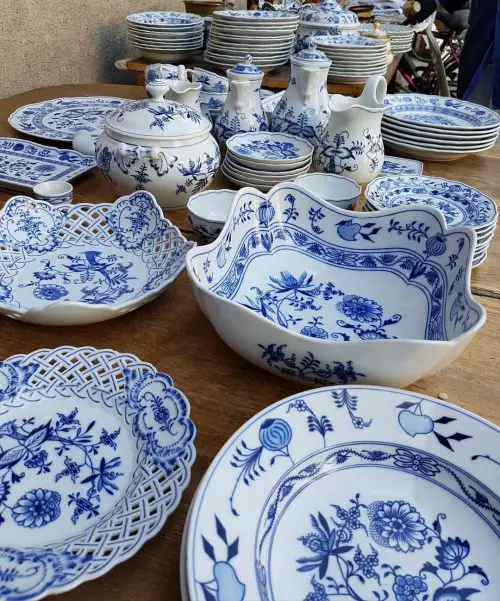
Meissen boasts 300 years of ceramic tradition and is known as the porcelain queen of Europe because it is one of the oldest porcelain makers on the continent. Back then, the German alchemist Johann Friedrich Böttger, who was trying to turn metal into gold, came up with the formula for porcelain.
The pieces made in Meissen, the oldest ones, are regarded as among the most expensive in the world. Many collectors would be more than willing to pay any amount for them.
The sharpness and detailed definition in each piece would stand out. Such details were obtained through the use of decorative molds. Sometimes, the pieces, which were imitations of baroque silver figures and Chinese ceramics, would be polished and shined before firing for a better finish.
The first dishes made were pretty plain, but over time and with the help of potters and artists, they began to implement designs as decoration.
One well-known design from Meissen is known as the ¨onion pattern¨, or Zwiebelmuster in its original language, and has been made for almost the 3 centuries of Meissen pottery’s existence. It is so famous that more than 60 companies around the world have copied it.
This is its design, and you will notice that it was probably copied because we have seen it at least once in our lives. Basically, the “onion pattern” means that it is decorated with flowers and one or another blue onion figure.
Destinations with ceramic tradition in Asia
10. Jingdezhen, China
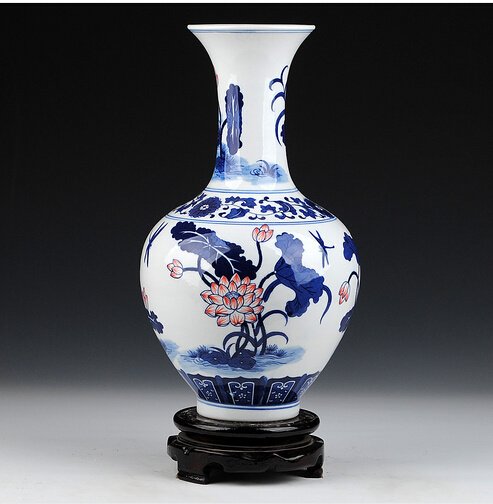
It is known as the Cradle and Capital of China’s Ceramics and Porcelain since it has a sixteen-century history in this industry. For centuries, Jingdezhen has been home to the emperors’ ceramic kilns in China and was also where the first artisan workshops in the whole country were established.
Jingdezhen is one of the largest suppliers of ceramics in the world. It supplies half of the world with its ceramic and porcelain cups, plates, and vases produced for the Chinese emperors.
Its porcelain pieces are famous for having 100% handmade decorations made in blue color that make them look very delicate and neat.
The Chinese government had the great idea of creating the Museum of History of Ceramics to show people from all over the world how they used to make their pieces in the imperial era. In addition, they have several ceramic kilns from the 14th century that shaped the history of this art in their country.
Although with this museum and throughout the city’s history it’s been sought, above all, to preserve the tradition of Jingdezhen pottery, younger and more contemporary artists want to include some new forms and concepts in their pottery tradition.
Of course, striking a balance between innovations and the respect and value that the past deserves. So, that is what they try to show with their creations, a mix of the tradition of their city, their ancestors, and the modernity they have learned about by traveling and getting to know new techniques and trends, as most modern potters do.
11. Arita, Japan
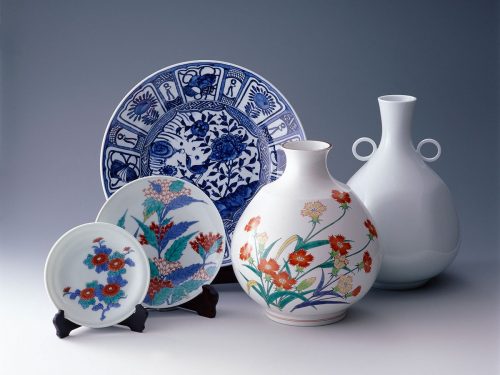
Arita is one of Japan’s most recognized cities when it comes to ceramics; it is believed to be the birthplace of Japanese porcelain, with a history of over 400 years.
Arita art pieces can be distinguished by their translucent white porcelain base, unique decorations of landscapes, flowers, animals, and some scenes with people, as well as the use of many colors that perfectly decorate the pieces.
Arita is also known for manufacturing a type of porcelain called Imari, which was highly prized by royalty and aristocracy during the 17th and 18th centuries in Europe and Turkey.
During the later years of this town’s history, strong ties have been created with the city of Meissen which is also famous for its porcelain, as we told you earlier.
To learn more about the history of Japanese ceramics and porcelain and Arita, we know the perfect place: The Arita Ceramics Museum. It is said that it hides the secrets of this porcelain and tells all about the town’s origins from a deeper and more intimate perspective.
Also, the Arita Pottery Festival is held every year from April 29 to May 5, where at least 500 handmade pottery stalls are set up along the 4 kilometers of the Sarayama, where you will have a look at Arita porcelain and get them at the fair prices.
We have reached the end of this blog and, as you can see in the images, there is always something similar between the ceramics of one culture or city to others, and this is because the history of ceramics has always been modeled after the inspiration of the oldest and most specialized or knowledgeable people.
We hope you have learned a lot about these 11 best destinations with ceramic tradition, through which you can learn more about the history of this art and how it developed in different parts of the world.


